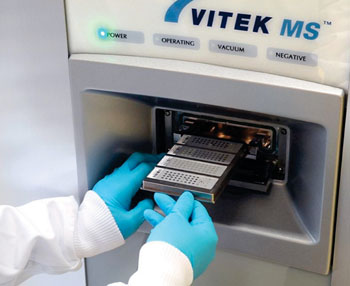Clinically Significant Yeasts Identified by MALDI-TOF MS Systems
By LabMedica International staff writers
Posted on 24 Sep 2014
The performance of two matrix-assisted laser desorption/ionization time-of-flight mass spectrometry systems (MALDI-TOF MS) has been evaluated for the identification of clinically significant yeast isolates. Posted on 24 Sep 2014
The rapid identification of pathogenic yeast species is helpful to start timely and effective antifungal therapy and this rapid identification can narrow the spectrum of therapeutic options, conceivably prevent treatment with toxic antifungal agents, improve the outcome, and reduce costs.

Image: The VITEK MS matrix-assisted laser desorption/ionization time-of-flight mass spectrometry system for microbial identification (Photo courtesy of BioMérieux).
Microbiologists at Kuwait University (Safat, Kuwait) collected a total of 188 clinically relevant fungal isolates obtained during one year of routine laboratory processing of clinical laboratory in a local hospital. The isolates were obtained from blood culture, bronchoalveolar lavage, cerebrospinal fluid, urine, wound, and high vaginal and endocervical swabs.
The identification of the clinical yeast isolates was initially achieved by VITEK 2 system (bioMérieux; Marcy l’Etoile, France). When necessary, one or more tests were also performed, morphology on Sabouraud dextrose agar (SDA), germ tube test for Candida species, and urease assimilation test for Cryptococcus species (Becton, Dickinson and Company; Sparks, MD, USA). Protein was extracted from the isolates and analyzed on MALDI-TOF Bruker MS (Bruker Biotyper, Bruker Daltonics; Bremen, Germany) and bioMérieux MALDI-TOF VITEK MS.
Accurate identification by VITEK 2 was 94.1% (177/188), by VITEK MS 93.0% (175/188), and by Bruker Biotyper MS 92.6% (174/188). Three isolates were not identified by VITEK MS, while nine Candida orthopsilosis were misidentified as C. parapsilosis, as this species is not present in its database. Eleven isolates were not identified or were wrongly identified by Bruker Biotyper and although another 14 were correctly identified.
The authors concluded that MALDI-TOF MS methods provide a standardized working protocol for the identification of yeasts from clinical specimens. The short turn-around time and expandability of the database demonstrate that this is a suitable first-line test for the identification of yeasts in the routine clinical microbiology laboratory. The study was published in the September 2014 issue of the International Journal of Infectious Diseases.
Related Links:
Kuwait University
BioMérieux
Becton, Dickinson and Company













